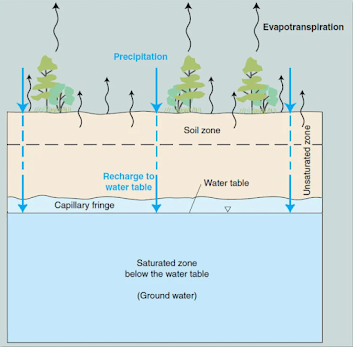The figure above shows the location of the unsaturated zone and the saturated zone.
Picture Source: From W.M. Alley et al., 1999, USGS Circular 1186: Sustainability of Groundwater Resources
There has been a contamination of infiltered water with fecal indicator bacteria in the Netherlands, Usually, the fecal bacteria stays in a barrier called the unsaturated zone which keeps the microbial contamination away from the soil surface and the groundwater. But, due to the amount of rainwater that has been occurring and the rise in groundwater, the bacteria in the unsaturation zone have been spilling over into the saturation zone. An experiment was held to compare the retention and release of Enterococcus moraviensis and Escherichia coli. The data of the rainfall event column experiment shows that E. moraviensis sticks to soil particles better than E. coli which causes it to not enter the sand columns. Leading us to the conclusion that E. coli can follow the flow of rainfall into our groundwater easily. This experiment is important to know so that we can minimize the risk of the contamination of our drinking water before it is too late. The agricultural field has a huge impact on the fecal indicator bacteria which leads to fecal pollution. The fecal pollution can have harmful pathogens that can affect the health of humans. Groundwater is one of our main freshwater supplies on earth if it is contaminated we are risking our health and loss of water supply. With the information we have learned today, we can find locations with safe levels of bacterial contamination and deter further contamination.
original article citation: Soltani Tehrani, R. Hornestra, L ., Dam, Jos van, Cirkel, Drik Gijsbert (2023). Transport and Retention of Fecal Indicator Bacteria in Unsaturated Porous Media: Effect of Transient Water Flow. http://doi.org/10.1128/aem.00219-23

No comments:
Post a Comment